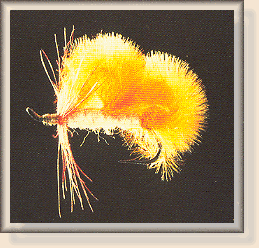|
Tying Steps:
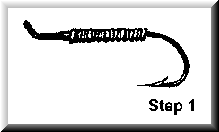
1. Wrap lead wire along the hook shank, lacquer it.

2. Tie in a clump of marabou fibres; let them dangle
for the moment.

3. Wrap a piece of pink sparkle yarn a third of the way up
the hook shank; tie it off, but do not cut the excess.
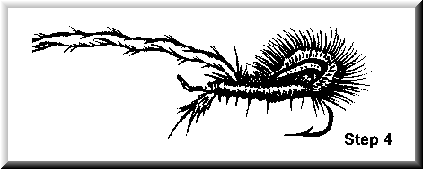
4. Pull the clump of marabou forward and tie it down.
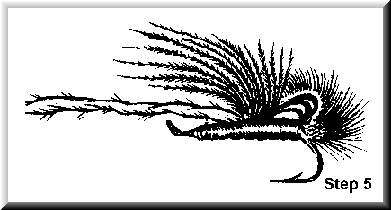
5. Tie in a second clump of marabou; let it dangle for the
moment.
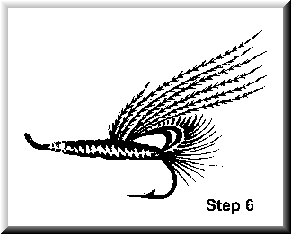
6. Wrap the piece of pink sparkle yarn two thirds of the way up
the hook shank.
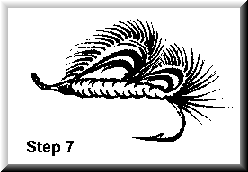
7. Pull the second clump of marabou forward and tie it down.
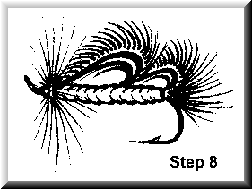
8. Wrap a scarlet hackle one turn; slant the hackle fibers backward
with turns of the thread. Whip finish.
Fishing the Marabou Spawn Sac:
Gold Creek [Montana] still has plenty of scars from mining
a hundred years later, but its cold and clear water invigorates the Clark
Fork. Around the mouth of the stream cutthroats push out into the main
river, joining the predominate brown trout.
There wasn't much excitement for the first few hours. Most of that
time was spent walking and searching for trout in Gold Creek itself,
starting two miles upstream and moving down towards the mouth. My
total catch was one small cutthroat.
Actually, I was starting to think that I should have gone to Lost Creek,
my favorite place for hunting spawners, but I had to keep looking for, in
Kevin Vause's words, " . . . there's one big brown trout, maybe 28
inches."
Then I started spotting groups of spawning fish up from the Clark
Fork in the final half mile of the stream. None of these brown trout
was Kevin's monster, but I did get three over 15 inches on a Marabou
Spawn Sac. All of the fish rushed the fly hard.
I had gone upstream two miles because I thought that the trout might
have moved from where Kevin saw him yesterday. When I spotted
him he was against a steep bank, at the end of a fallen log, and it
might well have been the exact water that Kevin had described to me.
He had the place right, which wasn't bad for a beginner flustered by a
huge trout. Kevin's estimate on the size of the fish looked off to me,
though, the trout maybe going 23 inches. The kype showed clearly
on the male, a richly spotted, dark fish.
On the first drift the trout ran up to meet the drifting Burnt Orange
Marabou Spawn Sac, stopped within an inch of it, and finally dropped
back downstream with the pattern (a type of inspection common with
dry flies but rare with a nymph). On my next few casts he ignored the
fly.
Unlike egg-eaters, spawners would take an egg pattern the first time or
not at all, disregarding it with a bit of disdain on every subsequent drift.
Once they knew it was a fraud, the fly couldn't stir up any more
aggression in them.
This brown trout passed up a series of Marabou Single Eggs and Glo
Bugs in a variety of colors, looking at only the yellow one. I was going to
change to a streamer, some type of yellow aggravator, when I sighted the
larger female under the log for the first time.
All I could think was that she was getting excited over my artificial hatch
of egg imitations. I put a bright Yellow Marabou Spawn Sac on and cast
further upstream than usual, aiming the drift for the top fish instead of the
bottom one. So what did the male do? He bolted up, flashing in front of
the female as she neared the fly, and sucked in the Spawn Sac.
I didn't want him any longer, not at the risk of spooking the female. I
let him mouth the fly, never setting the hook, and after carrying it downstream
for a moment he spit it out. I tried to draw the Spawn Sac aside, but he
grabbed it again.
Finally he let it go and I picked it up as gently as possible, plopping it
upstream for a repeat of the last drift.
Again he rushed up, and again he bullied the female off from the Spawn
Sac, but this time he didn't eat the fly himself. He repeated this routine,
facing off the more passive female without touching the Spawn Sac.
This battle of wills between us was now approaching nearly an hour,
and it was starting to get personal (and it didn't help that he was winning).
My only alternative, if he didn't get tired of this game of dare, was to
catch him and carry him in a bucket to a place, maybe another watershed,
far, far away. Then maybe it would be possible for me to come back
and hook the huge female.
On a hunch, I took off the Yellow Marabou Spawn Sac and put on the
Burnt Orange Marabout Sac again. The darker color didn't excite the
male as much and he let it pass along the log. On the third drift
the female positioned herself in front of the oncoming fly and sipped
it in gently.
She burst out of the run, going straight downstream through two smaller
pools, never trying to bury into cover. The male even started to follow
her, but when he saw me in the channel he flushed into deeper water.
The female, fighting spectacularly but not particularly intelligently in
the confines of the creek, was still fresh when she almost landed herself
on a gravel bar. She wasn't 28 inches, but with a bit of stretching on her
tail she touched 25 inches on the tape. She swam away strongly on the
release.
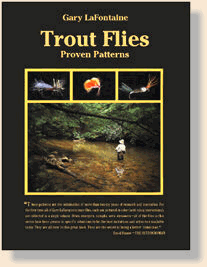
Those two brown trout were so different. The male was motivated by
aggression when he took the fly - the female simply craved a caviar
snack. The male actively tried to control the situation - the female
passively accepted the possibilities. ~ Gary LaFontaine
Credits: This article is an excerpt from Trout Flies - Proven
Patterns Published by Greycliff
Publishing.
For more great flies, check out:
Beginning Fly Tying and
Intermediate Fly Tying.
|

